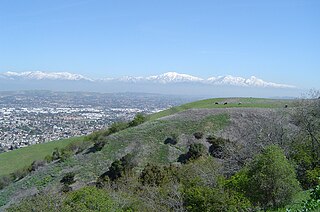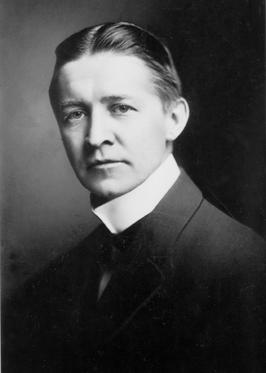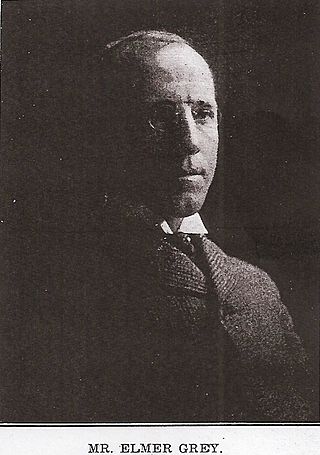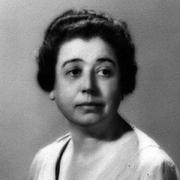
Montecito is an unincorporated town and census-designated place in Santa Barbara County, California, United States. Located on the Central Coast of California, Montecito sits between the Santa Ynez Mountains and the Pacific Ocean. Montecito is best known as a celebrity enclave, owing to its concentration of prominent residents. The population as of 2022 is approximately 8,638 residents.

The Spanish Colonial Revival Style is an architectural stylistic movement arising in the early 20th century based on the Spanish Colonial architecture of the Spanish colonization of the Americas.

The San Gabriel Valley, often referred to by its initials as SGV, is one of the principal valleys of Southern California, lying immediately to the east of the eastern limits of the city of Los Angeles and occupying the vast majority of the southeastern part of Los Angeles County. Surrounding landforms and other features include the following:

Bertram Grosvenor Goodhue was an American architect celebrated for his work in Gothic Revival and Spanish Colonial Revival design. He also designed notable typefaces, including Cheltenham and Merrymount for the Merrymount Press. Later in life, Goodhue freed his architectural style with works like El Fureidis in Montecito, one of the three estates designed by Goodhue.

Paul Revere Williams, FAIA was an American architect based in Los Angeles, California. He practiced mostly in Southern California and designed the homes of numerous celebrities, including Frank Sinatra, Lucille Ball and Desi Arnaz, Lon Chaney, Barbara Stanwyck and Charles Correll. He also designed many public and private buildings.
Peter Tolkin + Sarah Lorenzen Architecture (TOLO), formerly Peter Tolkin Architecture, is an architectural firm based in Los Angeles, California, established in 1998.

Myron Hubbard Hunt was an American architect whose numerous projects include many noted landmarks in Southern California and Evanston, Illinois. Hunt was elected a Fellow in the American Institute of Architects in 1908.

George Washington Smith was an American architect and painter. He is known particularly for his work around Santa Barbara, California, and for popularizing the Spanish Colonial Revival style in early 20th Century America. His notable works include Casa del Herrero, the Lobero Theater, the Santa Barbara News-Press building, and buildings at the Santa Barbara Cemetery. He also designed several private houses in Montecito.
The Southern California Association of Governments (SCAG) is the Metropolitan Planning Organization (MPO) of six of the ten counties in Southern California, serving Imperial County, Los Angeles County, Orange County, Riverside County, San Bernardino County, and Ventura County. San Diego County's MPO is the San Diego Association of Governments, which is an unrelated agency.

Elmer Grey, FAIA was an American architect and artist based in Pasadena, California. Grey designed many noted landmarks in Southern California, including the Beverly Hills Hotel, the Huntington Art Gallery, the Pasadena Playhouse and Wattles Mansion. He is credited with being one of the pioneers in the development of the new American architecture in the early 20th century, with a focus on harmony with nature and eliminating features not belonging to the local climate and conditions. Grey was also a noted artist whose paintings are in the permanent collection of the Chicago Art Institute.
The San Rafael Hills are a mountain range in Los Angeles County, California. They are one of the lower Transverse Ranges, and are parallel to and below the San Gabriel Mountains, adjacent to the San Gabriel Valley overlooking the Los Angeles Basin.

Carleton Monroe Winslow, also known as Carleton Winslow Sr., was an American architect, and key proponent of Spanish Colonial Revival architecture in Southern California in the early 20th century.
Francis W. Wilson was an American architect. His practice in Santa Barbara, California included work for the Atchison, Topeka and Santa Fe Railway and its associated Fred Harvey Company hotels, as well as many residences.
Roland Coate was an American architect. He designed many houses and buildings in California, three of which are listed on the National Register of Historic Places.

Katherine Emilie Bashford (1885–1953) was an American landscape architect who designed residential gardens primarily in Pasadena and landscaping for several Southern California public housing projects.

Michael Bauman Burch is a Southern California-based architect. He is a Fellow of the American Institute of Architects (FAIA). A fourth generation Southern Californian, Burch was raised in Pasadena, CA, and educated at the University of California, Berkeley and the Yale School of Architecture. He has taught at the University of Southern California. Burch founded his firm, Michael Burch Architects, in 1986. He was the original co-curator of an exhibition for the Getty Institute's Pacific Standard Time on the Spanish Colonial/Mediterranean Revival style. Burch's work has appeared in 20 books on the style, including the cover of "the definitive statement on the subject". He was invited to present the work of his firm at the Venice Biennale of Architecture in 2012, 2014, 2016, 2018 and 2020, as well as at Moscow's Schusev Architecture Museum in 2020. He has been described as "the greatest living practitioner of the Spanish Colonial/Mediterranean Revival style". In addition to numerous American Institute of Architects awards, his firm has received three Palladio Awards, the sole national award for traditional architecture.
Edwards and Plunkett was an American architectural firm active between 1925 and 1940 in Santa Barbara, California. It was founded by William Albert Edwards (1888–1976) and James Joseph Plunkett (1900–1946), who were among the most famous practitioners of the Spanish Colonial Revival style in Santa Barbara. From 1926 to 1928, Henry Ward Howell (1889–1962) was a junior partner, and they operated as Edwards, Plunkett, and Howell. Their works include the Arlington Theatre, the Janssens–Orella–Birk Building, and the original terminal building of the Santa Barbara Municipal Airport.













